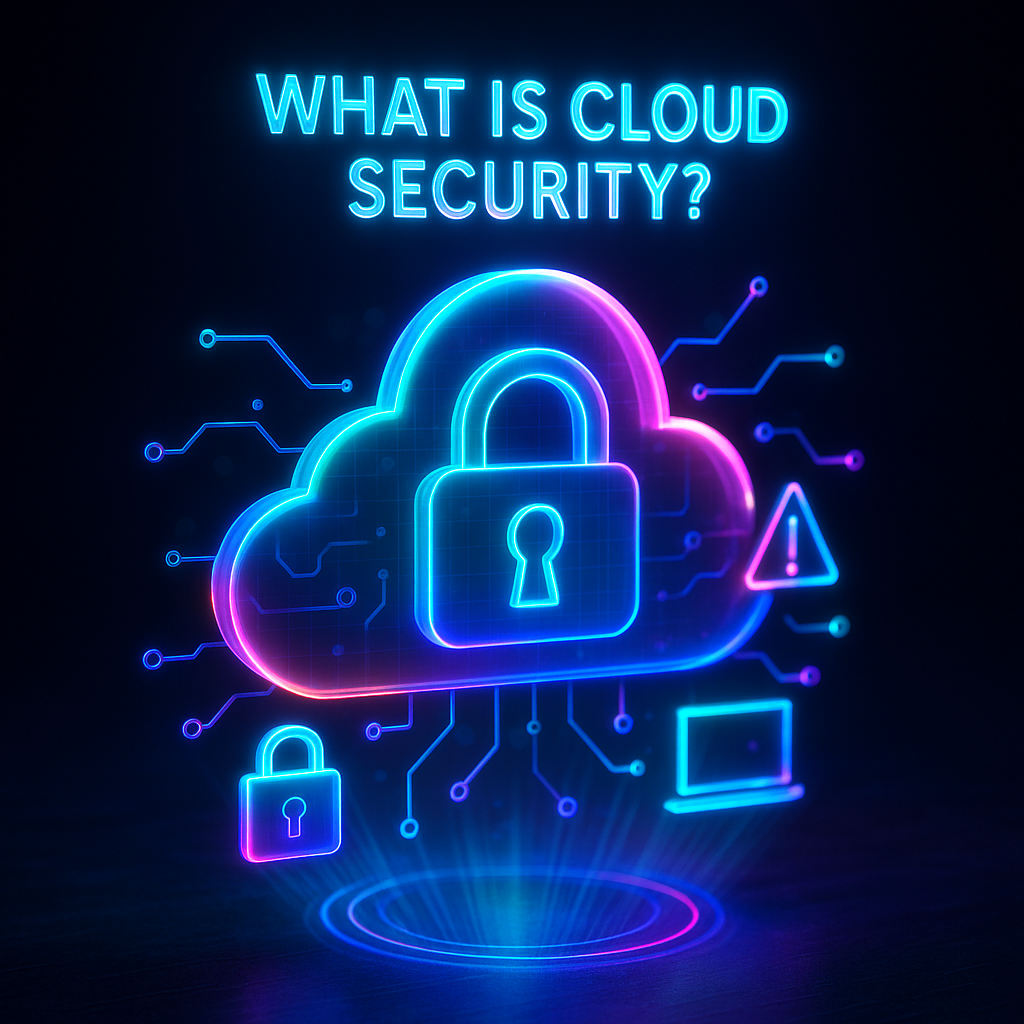Cloud computing has transformed the way businesses store, process, and share information. But with this transformation comes new risks. Every file uploaded to the cloud, every application deployed in a multi-cloud environment, and every SaaS tool integrated into business workflows expands the attack surface. That’s why cloud security has become a cornerstone of modern IT strategy.
This article answers the question what is cloud security, explains why it matters, outlines common threats, and provides best practices to keep your organization safe.
What Is Cloud Security?
In simple terms, cloud security is the collection of technologies, policies, procedures, and controls designed to protect data, applications, and infrastructure in the cloud.
Unlike traditional on-premises security, cloud security must cover distributed and dynamic environments. That means securing workloads across AWS, Azure, Google Cloud, and SaaS applications simultaneously.
A central concept is the Shared Responsibility Model in cloud security:
- Cloud providers (like AWS or Microsoft Azure) are responsible for securing the underlying infrastructure.
- Customers are responsible for securing the data, applications, access, and configurations they put into the cloud.
So when people ask what is cloud security definition, the answer is clear: it’s a shared framework to ensure confidentiality, integrity, and availability of cloud resources.
Core Pillars of Cloud Security
To truly understand what is cloud security in cyber security, it helps to break it down into core pillars:
- Identity and Access Management (IAM): Strong authentication methods like MFA, least privilege access, and Zero Trust architecture ensure only the right people and devices gain access.
- Data Protection: Encrypting data both at rest and in transit, deploying Data Loss Prevention (DLP) tools, and enforcing policies for sensitive information.
- Network Security: Using microsegmentation, Zero Trust Network Access (ZTNA), and secure gateways instead of traditional VPNs.
- Monitoring and Visibility: Centralized logging, SIEM tools, and User and Entity Behavior Analytics (UEBA) to detect anomalies early.
- Compliance and Governance: Meeting regulatory requirements like GDPR, HIPAA, and PCI-DSS.
These pillars give a holistic view of what is cloud security best practices.
Why Cloud Security Matters
The importance of cloud security cannot be overstated. Organizations face constant threats that can compromise data, disrupt operations, and cause reputational damage.
- Cloud adoption has skyrocketed, with businesses relying on SaaS, PaaS, and IaaS daily.
- Misconfigurations remain the number one cause of cloud breaches.
- Ransomware now regularly targets cloud backups and SaaS platforms.
In other words, the importance of cloud security comes from the reality that a single mistake in the cloud can lead to global-scale consequences.
Common Threats in Cloud Environments
When discussing cloud security threats, some patterns stand out:
- Data Breaches: Often caused by misconfigured storage buckets or exposed APIs.
- Insider Threats: Employees or contractors misusing access.
- Ransomware: Encrypting data and targeting cloud backups.
- API Exploits: Attackers abusing poorly secured APIs to gain entry.
- Supply Chain Attacks: Compromising third-party SaaS tools to infiltrate enterprises.
Understanding these risks is key to answering not just what is cloud security, but also how to defend against modern attacks.
How Cloud Security Works in Practice
Cloud providers build security into their platforms, but customers must configure and manage it properly. For example:
- Financial organizations use encryption and strong IAM to protect customer records.
- Healthcare providers rely on cloud security controls to maintain HIPAA compliance while storing medical data.
- SaaS startups implement Zero Trust access and CSPM (Cloud Security Posture Management) to meet enterprise security requirements.
This layered approach shows how cloud security tools operate in the real world.
Best Practices – How to Strengthen Cloud Security
When businesses ask how to improve cloud security, experts often recommend a layered defense strategy:
- Adopt Zero Trust: Never trust, always verify. Continuously validate users and devices.
- Encrypt Everything: Data in motion and data at rest should always be encrypted.
- Use CSPM or CNAPP Tools: Continuously scan for misconfigurations across multi-cloud environments.
- Manage Access with Least Privilege: Grant users and systems only the permissions they need.
- Run Tabletop Exercises: Test your incident response against simulated cloud security threats.
- Maintain Immutable Backups: Ensure ransomware cannot encrypt or delete them.
By following these cloud security best practices, companies reduce the chance of catastrophic breaches.
The Future of Cloud Security
So, what is the future of cloud security? Three major trends are already reshaping the landscape:
- Artificial Intelligence & Machine Learning: AI-driven anomaly detection is becoming essential for large-scale cloud environments.
- Cloud-Native Security: Security built directly into DevOps pipelines, often called DevSecOps.
- Evolving Regulations: New frameworks such as the EU’s Cyber Resilience Act and stricter Data Residency rules will push organizations to adopt stronger controls.
Cloud security is no longer just about defense — it’s about enabling innovation securely.
What is cloud security in simple terms?
Cloud security, in the simplest language, is about keeping your digital assets safe when they’re not stored on your own servers but in the cloud. Just like you lock the doors and install alarms at home, cloud security locks and monitors your data, applications, and systems when they live in cloud environments such as AWS, Azure, or Google Cloud. It covers everything from who can log in, to how files are encrypted, to how suspicious activity is detected and stopped.
Why is cloud security important?
Cloud security is critical because the risks are real and the consequences are severe. A single data breach can expose sensitive customer records, intellectual property, or financial details, leading to enormous fines, lawsuits, and loss of trust. Ransomware can halt operations for days or weeks, costing millions. Insider threats — whether accidental or malicious — can also compromise business continuity. Beyond protecting data, strong cloud security ensures compliance with regulations like GDPR or HIPAA, and gives customers confidence that their information is safe in your hands.
What are examples of cloud security controls?
Cloud security controls are the specific tools and practices that create defense layers. Examples include:
- Encryption: Scrambling data so only authorized parties can read it.
- Multi-Factor Authentication (MFA): Adding an extra step (like a code or biometric) beyond passwords.
- Zero Trust Network Access (ZTNA): Verifying identity and context before allowing any connection, instead of trusting everyone inside the network.
- Microsegmentation: Breaking networks into smaller zones to limit how far attackers can move.
- Compliance Monitoring: Continuously checking that systems meet security and regulatory standards.
Together, these controls form a robust shield against threats.
What are the biggest risks in cloud computing?
The biggest risks come from missteps and gaps rather than exotic hacks. Misconfigurations (like leaving a storage bucket open to the public) are the most common cause of breaches. Weak access management — such as over-privileged accounts or no MFA — creates easy entry points for attackers. Insecure APIs are another major issue; if not properly secured, APIs can be exploited as backdoors into cloud environments. Other risks include lack of visibility across multi-cloud systems and reliance on vendors who may not have adequate security.
Who is responsible for cloud security?
Responsibility is shared between the cloud provider and the customer. This is known as the Shared Responsibility Model. Cloud providers secure the underlying infrastructure — physical servers, storage, networking, and the basic cloud services. Customers are responsible for what they build and store on top of that: user access, application configurations, data protection, and compliance. For example, AWS will ensure its data centers are secure, but if a customer leaves an S3 bucket publicly exposed, that’s the customer’s fault. Effective cloud security depends on both sides doing their part.
Conclusion
So, what is cloud security? It’s the strategic blend of tools, policies, and practices that safeguard cloud-based resources from ever-evolving cyber threats. From IAM and encryption to compliance and monitoring, cloud security is the backbone of digital trust.
Organizations that embrace cloud security best practices don’t just reduce risk — they gain the confidence to innovate, scale, and deliver value without fear of disruption.
The bottom line: cloud security is not optional. It’s a business-critical discipline that every organization must prioritize today and adapt continuously for tomorrow.
Cloud Security Summary Table
Security Domain | Common Risks | Recommended Solutions |
Identity & Access Management (IAM) | Stolen credentials, excessive privileges, insider misuse | Multi-Factor Authentication (MFA), Zero Trust, Just-In-Time (JIT) access, Least Privilege policies |
Data Protection | Data breaches, ransomware encrypting cloud backups, unauthorized sharing | End-to-end encryption (in transit & at rest), Data Loss Prevention (DLP), Content Disarm & Reconstruction (CDR), immutable/offline backups |
Network Security | Lateral movement by attackers, exposed ports/services, VPN vulnerabilities | Zero Trust Network Access (ZTNA), microsegmentation, identity-based firewalls, closing inbound ports |
Monitoring & Detection | Late discovery of breaches, hidden insider threats, undetected API abuse | SIEM with centralized logging, UEBA (User & Entity Behavior Analytics), continuous posture management (CSPM/CNAPP) |
Compliance & Governance | Regulatory fines, lack of audit readiness, non-compliance with data residency laws | Compliance frameworks (GDPR, HIPAA, PCI), automated reporting, policy-as-code, regular audits |
Application Security | Vulnerable APIs, insecure DevOps pipelines, unpatched containers | Secure CI/CD (DevSecOps), IaC scanning, SBOMs (Software Bill of Materials), API authentication & rate limiting |
Third-Party & Supply Chain | Vendor breaches, SaaS compromise, weak contractor access | Vendor risk assessments, external MFA enforcement, continuous monitoring of partner sessions |





